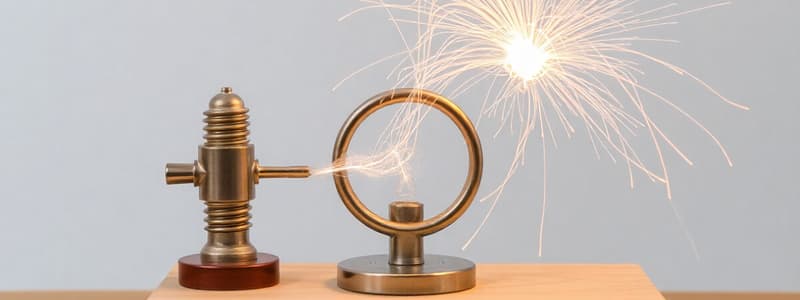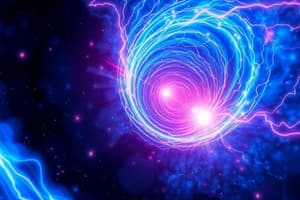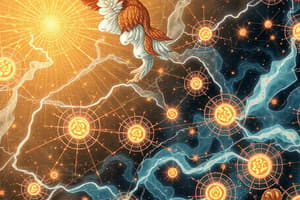Podcast
Questions and Answers
What is the primary function of the earth wire in electrical appliances?
What is the primary function of the earth wire in electrical appliances?
- To provide a high resistance path for current
- To increase the voltage of the current
- To keep the potential of the appliance equal to that of earth (correct)
- To conduct current away from the appliance
What is the typical current capacity of a circuit designed for high power appliances in a domestic setting?
What is the typical current capacity of a circuit designed for high power appliances in a domestic setting?
- 10A
- 5A
- 15A (correct)
- 20A
What occurs during a short circuit due to damaged insulation?
What occurs during a short circuit due to damaged insulation?
- Zero or negligible resistance to current flow (correct)
- The current is halted
- Resistance is increased
- Current is redirected to the earth wire
Which of the following best describes overloading in an electric circuit?
Which of the following best describes overloading in an electric circuit?
How can a fuse prevent overloading in an electrical circuit?
How can a fuse prevent overloading in an electrical circuit?
Which type of circuit arrangement is used to provide equal potential difference to each appliance?
Which type of circuit arrangement is used to provide equal potential difference to each appliance?
What happens to live wire during the heating effect according to Joule’s law?
What happens to live wire during the heating effect according to Joule’s law?
What is the consequence of connecting too many appliances to a single socket?
What is the consequence of connecting too many appliances to a single socket?
What happens to the galvanometer when both the bar magnet and coil are stationary?
What happens to the galvanometer when both the bar magnet and coil are stationary?
What is the effect on the galvanometer when the south pole of the magnet is used?
What is the effect on the galvanometer when the south pole of the magnet is used?
What induces a potential difference in the secondary coil?
What induces a potential difference in the secondary coil?
According to Fleming's Right Hand Rule, which finger represents the direction of the induced current?
According to Fleming's Right Hand Rule, which finger represents the direction of the induced current?
What happens to the galvanometer when current in coil-1 is turned off?
What happens to the galvanometer when current in coil-1 is turned off?
What is the highest induced current condition according to electromagnetic induction principles?
What is the highest induced current condition according to electromagnetic induction principles?
Which of the following describes electromagnetic induction?
Which of the following describes electromagnetic induction?
In the mutual induction experiment, what is the role of the primary coil?
In the mutual induction experiment, what is the role of the primary coil?
What did Hans Christian Oersted demonstrate about electricity and magnetism?
What did Hans Christian Oersted demonstrate about electricity and magnetism?
What happens to a compass needle placed near a current-carrying conductor according to Oersted's experiment?
What happens to a compass needle placed near a current-carrying conductor according to Oersted's experiment?
What happens to the strength of the magnetic field as the distance between field lines increases?
What happens to the strength of the magnetic field as the distance between field lines increases?
What is true about the magnetic field lines from a bar magnet?
What is true about the magnetic field lines from a bar magnet?
What indicates the strength of a magnetic field?
What indicates the strength of a magnetic field?
What rule can be used to determine the direction of the magnetic field around a current-carrying conductor?
What rule can be used to determine the direction of the magnetic field around a current-carrying conductor?
Why is it impossible for two magnetic field lines to intersect in a magnetic field?
Why is it impossible for two magnetic field lines to intersect in a magnetic field?
What does the north end of a compass needle align with?
What does the north end of a compass needle align with?
Which statement accurately describes a magnetic field?
Which statement accurately describes a magnetic field?
What observation occurs when the direction of current in a circuit is reversed?
What observation occurs when the direction of current in a circuit is reversed?
What occurs if the flow of current through a conductor is stopped?
What occurs if the flow of current through a conductor is stopped?
According to the Right Hand Thumb Rule, if you point your thumb in the direction of the current, what do your fingers represent?
According to the Right Hand Thumb Rule, if you point your thumb in the direction of the current, what do your fingers represent?
In Oersted's experiment, what material was used as the conductor?
In Oersted's experiment, what material was used as the conductor?
What is the relationship between electricity and magnetism when a current flows through a conductor?
What is the relationship between electricity and magnetism when a current flows through a conductor?
Which statement is true regarding the lines of magnetic fields?
Which statement is true regarding the lines of magnetic fields?
What describes the direction of the magnetic field around a straight conductor carrying current?
What describes the direction of the magnetic field around a straight conductor carrying current?
What direction does the middle finger indicate when using the right-hand rule?
What direction does the middle finger indicate when using the right-hand rule?
Which statement correctly contrasts Alternate Current (AC) and Direct Current (DC)?
Which statement correctly contrasts Alternate Current (AC) and Direct Current (DC)?
What is the frequency of AC in India?
What is the frequency of AC in India?
What is the role of the earth wire in domestic electric circuits?
What is the role of the earth wire in domestic electric circuits?
What is the potential difference between the live wire and neutral wire in a home circuit?
What is the potential difference between the live wire and neutral wire in a home circuit?
Which ACCURATE statement applies to the advantages of AC over DC?
Which ACCURATE statement applies to the advantages of AC over DC?
What is the color coding for the live wire in a domestic electric circuit?
What is the color coding for the live wire in a domestic electric circuit?
Which of the following accurately describes the nature of Direct Current (DC)?
Which of the following accurately describes the nature of Direct Current (DC)?
What rule is used to determine the direction of the magnetic field created by a current-carrying wire?
What rule is used to determine the direction of the magnetic field created by a current-carrying wire?
Which of the following statements is true about the magnetic field inside a solenoid?
Which of the following statements is true about the magnetic field inside a solenoid?
What happens when a soft iron rod is placed inside an energized solenoid?
What happens when a soft iron rod is placed inside an energized solenoid?
According to Andre Marie Ampere's suggestion, what happens when a current-carrying conductor is placed in a magnetic field?
According to Andre Marie Ampere's suggestion, what happens when a current-carrying conductor is placed in a magnetic field?
What effect does the configuration of a solenoid have on its behavior as a magnetic device?
What effect does the configuration of a solenoid have on its behavior as a magnetic device?
When a current-carrying conductor is placed between the poles of a magnetic field, what direction does it move?
When a current-carrying conductor is placed between the poles of a magnetic field, what direction does it move?
Which characteristic describes a solenoid when energized?
Which characteristic describes a solenoid when energized?
How does the magnetic field due to a current-carrying wire appear at the center of a loop?
How does the magnetic field due to a current-carrying wire appear at the center of a loop?
Flashcards
Oersted's Discovery
Oersted's Discovery
The relationship between electricity and magnetism was discovered by Hans Christian Oersted. He showed that an electric current produces a magnetic field.
Oersted's Experiment
Oersted's Experiment
A compass needle is a small bar magnet. When placed near a wire carrying an electric current, the needle deflects, indicating the presence of a magnetic field around the wire.
Magnetic Field
Magnetic Field
The region surrounding a magnet where its magnetic force can be felt. It's a vector quantity having both direction and magnitude.
Compass Needle
Compass Needle
Signup and view all the flashcards
Magnetic Field Lines
Magnetic Field Lines
Signup and view all the flashcards
Direction of Magnetic Field Lines
Direction of Magnetic Field Lines
Signup and view all the flashcards
Strength of Magnetic Field
Strength of Magnetic Field
Signup and view all the flashcards
Closed Curves
Closed Curves
Signup and view all the flashcards
Magnetic Field Line Density
Magnetic Field Line Density
Signup and view all the flashcards
Non-intersecting Magnetic Field Lines
Non-intersecting Magnetic Field Lines
Signup and view all the flashcards
Magnetic Field around a Straight Conductor
Magnetic Field around a Straight Conductor
Signup and view all the flashcards
Reversing Current Reverses Magnetic Field
Reversing Current Reverses Magnetic Field
Signup and view all the flashcards
Right Hand Thumb Rule
Right Hand Thumb Rule
Signup and view all the flashcards
Magnetic Field due to Current
Magnetic Field due to Current
Signup and view all the flashcards
Direction of Magnetic Field around a Straight Conductor
Direction of Magnetic Field around a Straight Conductor
Signup and view all the flashcards
Concentric Magnetic Field Lines
Concentric Magnetic Field Lines
Signup and view all the flashcards
Solenoid
Solenoid
Signup and view all the flashcards
Magnetic Field in a Solenoid
Magnetic Field in a Solenoid
Signup and view all the flashcards
Electromagnet
Electromagnet
Signup and view all the flashcards
Force on a Current-Carrying Conductor
Force on a Current-Carrying Conductor
Signup and view all the flashcards
Magnetic Field due to a Circular Loop
Magnetic Field due to a Circular Loop
Signup and view all the flashcards
North Pole of a Solenoid
North Pole of a Solenoid
Signup and view all the flashcards
South Pole of a Solenoid
South Pole of a Solenoid
Signup and view all the flashcards
Electromagnetic Induction
Electromagnetic Induction
Signup and view all the flashcards
Mutual Induction
Mutual Induction
Signup and view all the flashcards
Maximum Induced Current
Maximum Induced Current
Signup and view all the flashcards
Fleming's Right Hand Rule
Fleming's Right Hand Rule
Signup and view all the flashcards
Induced EMF
Induced EMF
Signup and view all the flashcards
Electrical Generators
Electrical Generators
Signup and view all the flashcards
Lenz's Law
Lenz's Law
Signup and view all the flashcards
Magnetic Flux
Magnetic Flux
Signup and view all the flashcards
Alternating Current (AC)
Alternating Current (AC)
Signup and view all the flashcards
Direct Current (DC)
Direct Current (DC)
Signup and view all the flashcards
Advantages of AC for Transmission
Advantages of AC for Transmission
Signup and view all the flashcards
Domestic Electric Circuits
Domestic Electric Circuits
Signup and view all the flashcards
Live Wire
Live Wire
Signup and view all the flashcards
Neutral Wire
Neutral Wire
Signup and view all the flashcards
Earth Wire
Earth Wire
Signup and view all the flashcards
Distribution Box
Distribution Box
Signup and view all the flashcards
Short Circuiting
Short Circuiting
Signup and view all the flashcards
Overloading
Overloading
Signup and view all the flashcards
Fuse
Fuse
Signup and view all the flashcards
Parallel Connection
Parallel Connection
Signup and view all the flashcards
Separate Switch for Each Appliance
Separate Switch for Each Appliance
Signup and view all the flashcards
Two Circuits in Domestic Wiring
Two Circuits in Domestic Wiring
Signup and view all the flashcards
Study Notes
Chapter 13 - Magnetic Effects of Electric Current
- Oersted's experiment demonstrated the relationship between electricity and magnetism.
- Oersted observed that a compass needle placed near a current-carrying wire exhibited deflection.
- Reversing the current direction reversed the needle's deflection.
- This signifies a connection between electricity and magnetism, creating a magnetic field around the conductor.
- A magnetic field encircles a current-carrying conductor.
- The strength of the field depends on the proximity to the conductor; closer lines indicate a stronger field.
- Magnetic field lines are closed curves extending from the north pole to the south pole outside the magnet and from south to north pole inside.
- Magnetic field lines never intersect.
- The right-hand thumb rule helps determine the direction of a magnetic field generated by a current-carrying conductor: point the thumb in the current direction; the curled fingers indicate the field direction.
- A solenoid (a coil of wire) exhibits a uniform magnetic field within its core, with one end acting as a north pole and the other as a south pole.
- An electromagnet is created by placing magnetic material within a solenoid, amplifying the magnetic field.
- A current-carrying conductor in a magnetic field experiences a force perpendicular to both the current and the magnetic field directions.
- This is described by Fleming's left-hand rule.
- Current and magnetic field influence the direction and magnitude of the force on the conductor.
- Electromagnetic induction is the process of inducing an electromotive force (EMF) or voltage in a conductor by changing the magnetic field around it.
- Moving a magnet near a coil of wire generates a current in the coil.
- Changing the current in a coil induces a current in a nearby coil (mutual induction).
- Self-induction is the phenomenon where changing current in a coil induces a voltage in the same coil.
AC vs DC
- Alternative Current (AC) has varying direction, while Direct Current (DC) flows consistently in one direction.
- AC transmission is more efficient over long distances.
Domestic Circuits
- Domestic circuits use 220V (in India) potential difference at 50Hz frequency.
- Three wires are crucial: live (high potential), neutral (0V potential), and earth (safety ground).
- Earth wire protects against electric shocks.
- Fuses and circuit breakers prevent overloading and short circuits.
- Overloading occurs when the current drawn by appliances exceeds the cable's capacity.
- A short circuit happens when live and neutral wires come in direct contact.
Study Materials, Questions and Answers.
- The supplied material includes questions on various topics in the chapter.
Studying That Suits You
Use AI to generate personalized quizzes and flashcards to suit your learning preferences.



